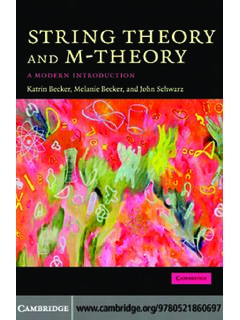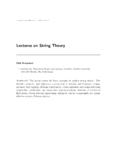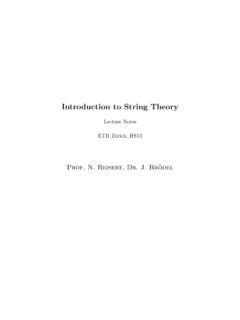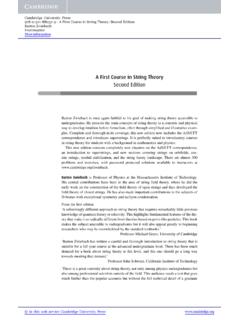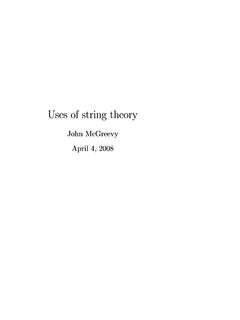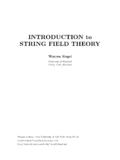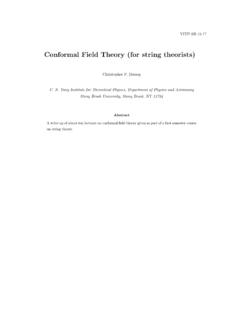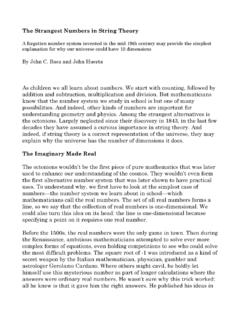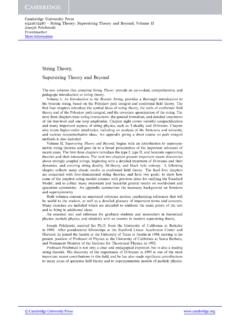Transcription of String Theory I - TU Wien
1 Lecture notesString Theory term 08/09 Maximilian KreuzerInstitut f ur Theoretische Physik, TU Wien+43 1 58801-13621 Wiedner Hauptstra e 8 10, A-1040 kreuzer/ String unification .. History of String Theory .. 62 The bosonic The Polyakov action .. Local symmetries and gauge fixing .. Open strings .. Target space symmetries and conservation laws .. Classical solutions and light cone gauge .. Poisson brackets and Virasoro algebra .. 213 Quantization of bosonic BRST quantization .. Conformal anomaly and critical dimension .. Physical states .. Strings in background fields .. BRST cohomology and no ghost theorem .. 354 The RNS model .. Consistent superstrings in 10 dimensions.
2 43 Chapter 1 IntroductionAs it became clear that general relativity and Maxwell s Theory are both intimately tied to theconcept of local symmetries, a unified description of the forcesof nature became general relativity (GR), a local choice of coordinates has to be made and the action is alocal functional of the metric and of the matter fields that isindependent of this choice. Elec-trodynamics (ED) can be described very efficiently by a vector potentialA = ( ,~A), with thefield strengthsF = A A being invariant under gauge transformations A = (x )[H. Weyl, 1918]. While classical physics can be formulated in terms of the field strengths,a local description of the coupling to quantum mechanical wave functions requires the gaugepotentials, as is illustated by the Aharonov Bohm effect [ah59].
3 A promising framework for unification was suggested by Kaluza and Klein [ka21]: Theyproposed that space-time is 5-dimensional, but with only 4 approximately flat directions andwith one direction curled up on a small circle. Then the off-diagonal entry of the metricA :=g4 transforms as a vector from the 4-dimensional point of view andserves as thegauge potential. Surprisingly, with this simple ansatz one recovers the complete set of Maxwellequations as a subset of the 5-dimensional Einstein equations. Inaddition, a scalar field =g44shows up, but since the prediction of a new particle was beyond the scope of pre-quantumphysics the consequences of this fact were discussed only much later. Moreover, it was notclear what mechanism could make the 5th dimension curl up and inthe 1920s it was not evenpossible to pose this question within any proper framework, which certainly has to incorporatea quantum mechanical treatment of the gravitational a long development of quantum field Theory , techniques for a perturbative analysis ofquantum gravity became available in the 60s [fe63,De65].
4 At about the same time the standardmodel of strong and electroweak particle interactions, anSU3 SU2 U1gauge Theory thatis spontaneously broken toSU3 U1below the Fermi scaleG 12F= [data], wasconstructed. This led to the discovery of asymptotic freedom [co73] of QCD and a decadeString Theory I 1 versionMay 5, 2010later to the detection of theWandZbosons that mediate weak interactions. Attempts at agroup theoretical grand unification of the standard model by a gauge Theory withSU5[ge74]or even larger gauge groups [sl81] produced surprisingly good predictions for the ratio of theWandZmasses and, at the same time, lead to a unification scale of 1014 1016 GeV, far abovethe Fermi scale 300 GeVof weak interactions. Since quantum gravity is bound to becomeimportant at the Planck mass1 MPl=p~c/GN= 1019 GeV/c2, this may be regarded asan indication that gravity should no longer be ignored in particle turned out that a perturbative quantization of gravity isspoiled by non-renormalizability, an infinite number of divergent quantum corrections that cannot be controlled by symme-tries.
5 An important example of such a correction is the one that modifies the cosmologicalconstant (the energy density of the vacuum, which becomes observable in gravitational in-teractions). The experimental bound for its physical value isbest characterized by the tinydimensionless ratio| |/M2Pl<10 121[data].2It is clear that such a tiny quantity should be ex-plained by a symmetry, the only known candidate for which is supersymmetry (SUSY) [WE83]:Note that the energy of a harmonic oscillator isE=12 (a a aa ) = (a a 12) for excitationmodes that are quantized according to bosonic/fermionic statisticsa a aa = 1. The zeropoint energies are, therefore, of equal size and opposite energy operators for secondquantized free fields consist of an infinite sum of such oscillator terms.
6 In order to have a can-cellation of zero point energies we should thus have an equal number of bosonic and fermionicdegrees of freedom and a symmetry that controlls the cancellation when interactions are turnedon. Due to the spin statistics theorem [ST64] aphysicalsymmetry that transforms commutinginto anti-commuting fields should be in a spin 1/2 representation of the Lorentz group andshould be implemented by an anticommuting operator, the superchargeQ , in Hilbert the anti-commutator of two SUSY transformations generates translations [WE83],the local (or gauged) version of supersymmetry automatically contains gravity and is hencecalled supergravity (SUGRA). In the late 70s and early 80s it washoped that SUGRA mightcure the divergences of quantum gravity.
7 This also lead to a revival of the old ideas of Kaluzaand Klein, but now with a higher dimensional compactificationspace in order to be able toincorporate the whole standard model of particle interactions into a (super)geometrical was shown that the standard model can only be obtained from atleast 11 dimensions, which,at the same time, is the maximal dimension allowed for it is hard to getchiral fermions by starting in an odd number of dimensions [ba87]. The alternative of adding1 IncgsunitsMP l= 10 5g; the corresponding length scale isp~GN/c3= 10 experimental bound for the photon mass ism <3 10 33 MeV, so that electromagnetic gaugeinvariance appears to be an exact symmetry of Weyl fermion has 2d/2 1components ind(even) dimensions, while a massless vector field and a spin 2graviton haved 2 andO(d2) degrees of freedom, respectively.
8 Accordingly, the structure of SUSY and SUGRA strongly depends on the space-time dimension and SUGRA ind >11 would imply the existence of fundamentalparticles with spinj >2, for which no consistent interactions are Theory I 2 versionMay 5, 2010 Fig. 1:g= 2 world sheet and some corresponding 2-loop Feynman graphs. =+@@ @@n+AAA AAA+ gauge symmetries to a 10-dimensional Theory by hand goes against the original spirit of theideas of Kaluza and Klein. Even worse, it turned out that SUGRA could not solve the problemwith String unificationString unification apparently works in a rather different way: Here the fundamental object is athread or a loop in space-time which, during time evolution, sweeps out a surface that is calledworld sheet(in analogy to the world line of a point particle).
9 The dynamics is described by anaction that is proportional to the area of that surface, and hence in purely geometrical are oscillation modes of the String , and interactions occur by joining and splitting ofstring configurations, as is shown in Fig. 1. This has two important consequences: There is no interactionpoint(the apparent splitting point changes under Lorentz trans-formations), which avoids the UV divergences of second quantized point particle Theory . There is a unique geometrical interaction, which unifies an apriory infinite number ofindependent couplings among different , String Theory leads to a unification of interactionsandto a unification of a more modern point of view we may think of the world sheet as an independenttwo-dimensional space with local coordinates m.
10 The String coordinate functionsX ( ) arequantum fields on that space and describe its embedding into atarget space, which may itselfbe a topologically non-trivial manifold with local coordinatesX . The geometrical descriptionof the action ensures that it can be constructed in a coordinateinvariant way as a sum overterms that are defined via local coordinates. For historical reasons such a quantum field theoryis called asigma model. Unfortunately, there are two big problems with this approach: Scattering amplitudes are only defined as an infinite sum over different world sheet topolo-gies, we do not have a non-perturbative definition of String Theory . The sum overtopologies may be badly divergent. To define a String Theory we need to choose some fixedbackgroundtarget space geometry(or, in a more abstract description, a conformal field Theory ).
